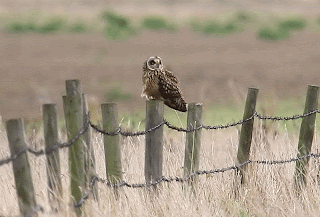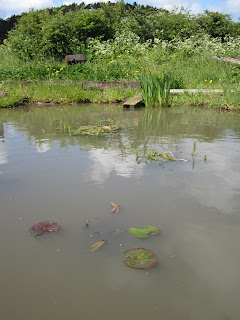 |
| One of the British Birds oils by Charles Collins (1736) |
Before the
standardising of scientific nomenclature and greater understanding of
the genetic groupings of species classification was largely based on
physical appearance, behaviour and habitat. As an example, reed
buntings and sedge warblers, both small, brown and streaked
passerines were referred to as reed sparrows. These, and a selection
of some other obsolete but intriguing names were found on the backs
of a series of oil paintings hanging in the Panelled Lobby at the
National Trust's Anglesey Abbey in Cambridgeshire. Painted by
Charles Collins (1680 – 1744) in 1736 these oils are a valuable
early source of English names, some of which are found in other
sources and some that may have been regional to Collins's native
Ireland or even falling out of use at the time.
Below is a selection of
some interesting examples of old, local and obscure avian
nomenclature including the most unusual from the Collins oils
(denoted with CC 1736).
Weasel Coot
Of
unknown origin, this is a rather bizarre East Anglian name for
redhead Smew.
Susie
(female
Mallard) This is a term used mostly by wildfowlers.
Hanser
East
Anglian for Heron. This is a regional variant of a name that was
probably fairly widespread across England. It features in one odd
form in Shakespeare's Hamlet in the line “I am but mad
north-north-west. When the wind is southerly, I know a hawk from a
handsaw.” I still come across some old Norfolk boys and gels who
use this name.
Wind Hover
(Kestrel)
This is a fine example of a behavioural name.
 |
| Lapwing at Cley (Phil Farndon) |
Hornpie, Green
Plover, Peewit
The
Lapwing is a bird has an impressive collection of names, and it is
easy to understand why this distinctive and beautiful plover has
caught the imagination of people over the centuries. Hornpie is the
Norfolk dialect name.
Seapie
(Oystercatcher)
Derived from the same root as the Hornpie, with the 'pie' referring
to the black and white appearance of the bird.
Drain Swallow,
Whistling Snipe, Tree Sandpiper
(Green
Sandpiper) All three of these now obscure names are far more
descriptive of the bird than the now standard name.
 |
| Barn Owl at Wiveton (Phil Farndon) |
Billy Wise
(Barn
Owl) A rather charming example of proper Norfolk.
Bank Martin (CC
1736)
(Sand
martin)
Ox-eyed Titmouse (CC
1736)
(Great
Tit) The family of birds we now know as tits were until relatively
recently called titmice.
Colemouse (CC
1736)
(Coaltit)
Bum Barrel
(Long-tailed
Tit) Another Norfolk name.
Mavis (CC
1736)
(Song
Thrush) Another once common name.
Storm Cock
(Mistle
Thrush) Anyone who has heard a mistle thrush in full song at the
very top of a tall tree in rough winds before a storm will understand
just how apt this name is.
Titlark (CC
1736)
(Meadow
pipit) A fine example of describing a bird in terms of two more
familiar species.
 |
| Stonechat at Cley (Phil Farndon) |
Stone Cutter (CC
1736)
(Stonechat)
Beam Bird (CC
1736)
(Spotted
Flycatcher) There is no obvious derivation for this. My own theory
is that this species may have been in the habit of using the beams of
animal shed and barns as a perch when catching insects.
Small Reed Sparrow
(CC 1736)
(Sedge
Warbler)
Grasshopper Lark (CC
1736)
(Grasshopper
Warbler)
Golden Crowned Wren (CC 1736)
(Goldcrest)
Butcher Bird (CC
1736)
(Great
Grey Shrike) This name is derived from the habit shrikes have of
impaling there prey on thorns, as a butcher would hang meat.
Aberdevine (CC
1736)
(Siskin)
Of unknown origin, but used for this species mostly when kept as a
cage bird.
Pink or Spink
(Chaffinch)
Variations on this onomatopoeic name are found across the country.
Spink is the East Anglian variant and Pink is used in the Midlands.
Bramble Finch (CC
1736)
(Brambling)
Reed Sparrow (CC
1736)
(Reed
Bunting)
















































